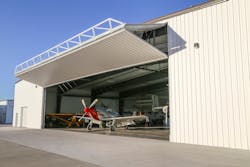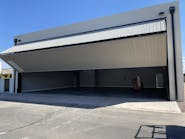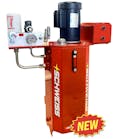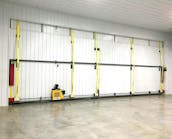Repairs and updates to equipment are simply unavoidable. Though small adjustments and fixes are to be expected, at some point, the maintenance scale tips and a new equipment purchase offers the best solution. Bi-fold and hydraulic doors present the same decisions as all other equipment. Purchasing a new door may be the best option, but there’s a lot to take into consideration before investing in a brand-new door.
Reasons to replace an oversized door include more than just an obvious non-working door. A building owner might also replace a door to accommodate the growing size of machinery, which requires larger doors; or when they’re looking for a cosmetic update to increase the value of the building. No matter the reasoning behind it, there are five key points to consider before replacing a door: the comparison between repair and replacing, safety, building capacity, style and technology, and the importance of consulting a professional.
Repair vs. replace
High-quality doors typically last upwards of 20 years. However, necessary maintenance and repairs become more and more common as a door ages. The frequency at which a door opens and closes can also deteriorate parts faster, and common elements such as door seals and mechanical components regularly require repairs or replacing.
Visual indicators of wear and damage include the seals and weather strips of a door. Watch for cracks, tears or broken pieces on the door’s seals. Without proper sealing, building owners risk increased energy costs. This simple repair, which usually costs less than $100, often results in annual cost savings.
An inconsistent or non-functioning lifting operator may be cause for door replacement. A cost-saving and effective solution – which many manufacturers offer – is replacing the motor without having to replace the entire door, if the door frame is structurally sound.
Overall, if a door’s problems are costing $250-$500 in repairs every six months, consider replacing the door and operating system.
Other factors such as safety may also be ample cause for replacement.
Safety
Improperly functioning overhead doors present life-threatening risks. If a 2,000-pound door malfunctions and gravity takes over, any people, equipment or vehicles in the way are in danger. Most overhead door manufacturers have a design factor safety element used in the manufacturing process to help avoid such accidents, but older models may not have safety designed into the door.
Safety sensors aren’t new technology, but not all doors feature them. Choose a door with photo eyes or safety-sensing edges to recognize if an obstruction is in the way as it closes. Photo eyes transmit a beam a few inches from the floor, and if something breaks the beam, the door recognizes it and stops. Similarly, safety sensing edges attach to the bottom of the doorframe and cause the door to stop if an obstruction meets them.
Trying to open a door while it’s locked in place raises safety concerns, and often results in damage and expenses. Unless a door has an automatic latch, a single latch handle needs to be manually released prior to opening the door. Look for a single latch handle that incorporates a safety switch to prevent the door from starting until it’s unlocked. Some manufacturers also offer optional top override switches, which serve as backup safety switches if the limit switch in the control box fails. When contact is made with the override switch, it stops the door from traveling past its opening height.
Last, check to see if the manufacturer has a high safety rating. For example, a door with a 5 to 1 safety rating indicates that the cables and straps opening the door can withstand stress that is five times greater than the weight of the door.
Before ordering a door, confirm that it has the necessary safety features. Save on costly replacements and prevent potential injuries by confirming safety sensors, safety switches and the safety rating.
Building capacity
An oversized door should only be paired with a sturdy frame. In fact, it’s nearly impossible to mount a new bi-fold or hydraulic door without the proper frame. If a current structure is damaged or the steel is rusted, the frame may be repairable. If not, the manufacturer or contractor will need to fit and install a new doorframe with the new door.
Besides the frame, the building itself should be inspected to ensure it can handle the weight of a large door. A good manufacturer will inspect the structure, from the jamb and steel header to the foundation, ensuring the building is structurally acceptable if a retrofit is necessary. The manufacturer and contractor will work closely to ensure the building is braced properly to handle the loads of the door.
The structure of a building often determines whether a bi-fold or hydraulic door present a better option. Each applies different amounts of weight to the building, and the placement of the door makes a difference as well. A hydraulic door is often a better option for openings on the side instead of the front of a building. Bi-fold doors, on the other hand, are mounted above the opening, so if it’s being installed on a side wall, there’s not typically enough room above it to stay below the roofline of the building.
When choosing between a bi-fold and hydraulic door, consider all aspects and features.
Style & technology
Bi-fold and hydraulic doors each offer characteristics that make them an attractive option for different situations. For example, bi-fold doors raise upward instead of outward, requiring less operating space in front of the building. Hydraulic doors, on the other hand, open faster, providing an ideal solution for a heat-controlled building. In fact, hydraulic doors open as much as 25 percent faster than other large doors.
Doors can be custom designed to fit nearly any aesthetic requirements. From glass, wood and siding to a combination of materials, the possibilities are only limited by the imagination. This delivers an appealing aesthetic, allowing the door to blend in with the existing material on the building’s exterior.
When choosing a bi-fold door, look for solid welded construction rather than bolt-together designs. Solid welded doors offer a strong frame design with minimal chance of parts loosening over time, resulting in virtually no maintenance.
Along the same lines, when choosing a hydraulic door, select one made of all-steel construction rather than a combination of wood and steel. A door built with heavy-gauge steel tubing and a robust truss system delivers strength and durability.
Besides safety features like sensors and switches, there are a number of maintenance-friendly options and modern conveniences available. Choose from override systems, high wind-load ratings, insulation and door liners, walk-through doors and windows.
Consult a professional
With all of these factors to consider, working with the right manufacturer can make all the difference. Choosing a manufacturer that has its own trained employees and equipment ensures the door installation is done right. Select one who understands what it takes to make a door that lasts, and one willing to work one-on-one to build the perfect door. Find a company that will take on the whole process, from consultation to completed work. A partnership with the right manufacturer means questions get answered and ensures the door is done right the first time.
Jason Myrvik is the general manager at Midland Door Solutions, which manufactures and installs bi-fold and hydraulic doors for new and existing buildings. He has more than 19 years of industry experience. As general manager, he oversees the manufacturing and installation departments, ensuring the best customer service from door design to production to on-site installation. Contact him at [email protected].



